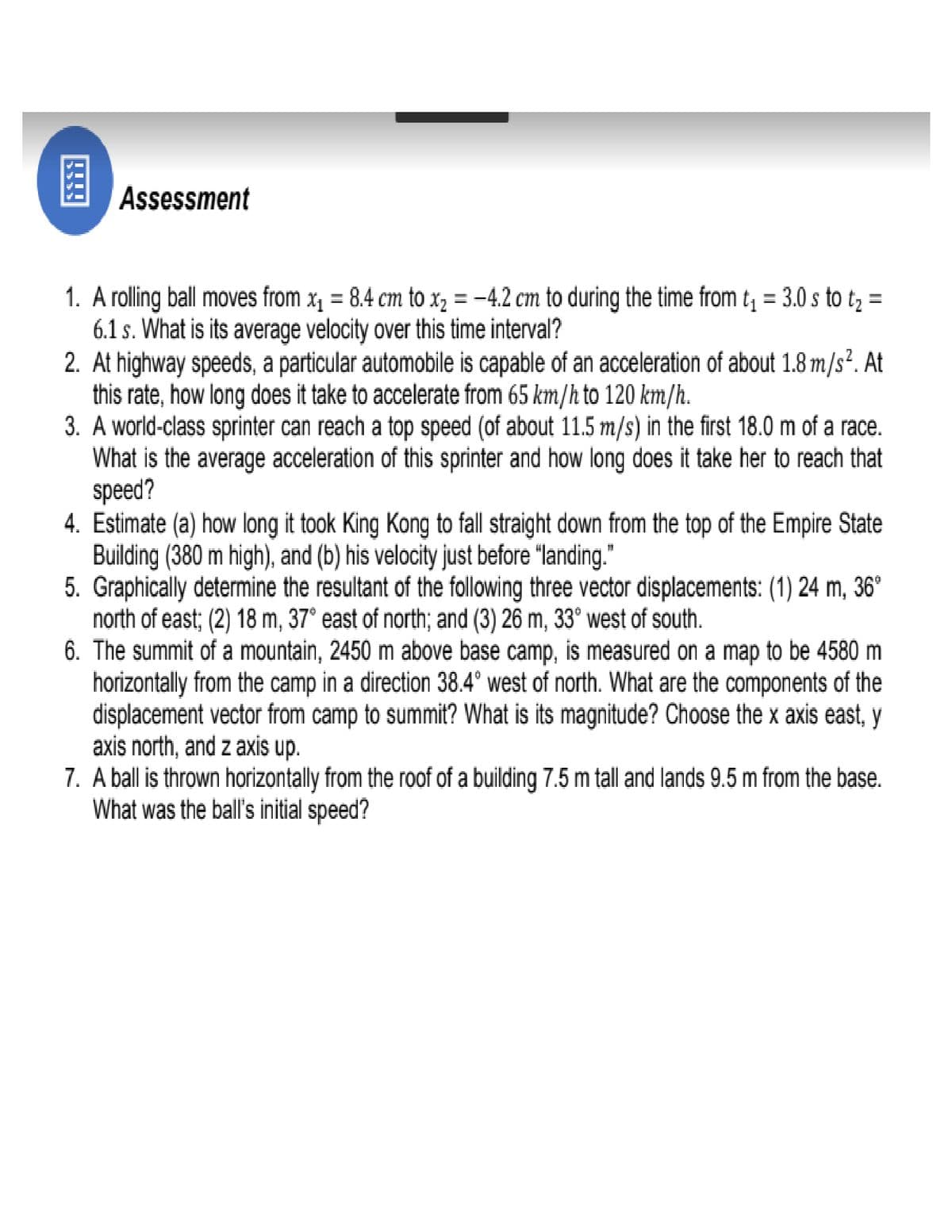1. A rolling ball moves from x1 = 8.4 cm to x2 = -4.2 cm to during the time from t, = 3.0 s to tz = 6.1 s. What is its average velocity over this time interval?
1. A rolling ball moves from x1 = 8.4 cm to x2 = -4.2 cm to during the time from t, = 3.0 s to tz = 6.1 s. What is its average velocity over this time interval?
Physics for Scientists and Engineers: Foundations and Connections
1st Edition
ISBN:9781133939146
Author:Katz, Debora M.
Publisher:Katz, Debora M.
Chapter2: One Dimensional Motion
Section: Chapter Questions
Problem 30PQ: A The instantaneous speed of a particle moving along one straight line is v(t) = ate5t, where the...
Related questions
Question
Answer question number 1

Transcribed Image Text:Assessment
1. A rolling ball moves from x, = 8.4 cm to x, = -4.2 cm to during the time from t, = 3.0 s to t, =
6.1 s. What is its average velocity over this time interval?
2. At highway speeds, a particular automobile is capable of an acceleration of about 1.8 m/s². At
this rate, how long does it take to accelerate from 65 km/h to 120 km/h.
3. A world-class sprinter can reach a top speed (of about 11.5 m/s) in the first 18.0 m of a race.
What is the average acceleration of this sprinter and how long does it take her to reach that
speed?
4. Estimate (a) how long it took King Kong to fall straight down from the top of the Empire State
Building (380 m high), and (b) his velocity just before "landing."
5. Graphically determine the resultant of the following three vector displacements: (1) 24 m, 36°
north of east; (2) 18 m, 37° east of north; and (3) 26 m, 33° west of south.
6. The summit of a mountain, 2450 m above base camp, is measured on a map to be 4580 m
horizontally from the camp in a direction 38.4° west of north. What are the components of the
displacement vector from camp to summit? What is its magnitude? Choose the x axis east, y
axis north, and z axis up.
7. A ball is thrown horizontally from the roof of a building 7.5 m tall and lands 9.5 m from the base.
What was the ball's initial speed?
Expert Solution
This question has been solved!
Explore an expertly crafted, step-by-step solution for a thorough understanding of key concepts.
This is a popular solution!
Trending now
This is a popular solution!
Step by step
Solved in 3 steps

Knowledge Booster
Learn more about
Need a deep-dive on the concept behind this application? Look no further. Learn more about this topic, physics and related others by exploring similar questions and additional content below.Recommended textbooks for you

Physics for Scientists and Engineers: Foundations…
Physics
ISBN:
9781133939146
Author:
Katz, Debora M.
Publisher:
Cengage Learning

College Physics
Physics
ISBN:
9781938168000
Author:
Paul Peter Urone, Roger Hinrichs
Publisher:
OpenStax College

Physics for Scientists and Engineers with Modern …
Physics
ISBN:
9781337553292
Author:
Raymond A. Serway, John W. Jewett
Publisher:
Cengage Learning

Physics for Scientists and Engineers: Foundations…
Physics
ISBN:
9781133939146
Author:
Katz, Debora M.
Publisher:
Cengage Learning

College Physics
Physics
ISBN:
9781938168000
Author:
Paul Peter Urone, Roger Hinrichs
Publisher:
OpenStax College

Physics for Scientists and Engineers with Modern …
Physics
ISBN:
9781337553292
Author:
Raymond A. Serway, John W. Jewett
Publisher:
Cengage Learning